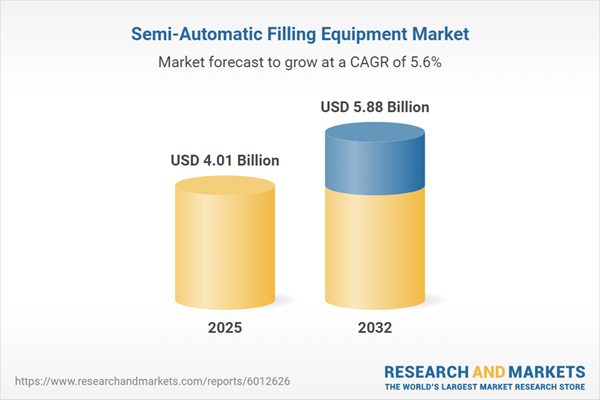Speak directly to the analyst to clarify any post sales queries you may have.
Semi-automatic filling equipment is transforming modern manufacturing, providing senior decision-makers with enhanced flexibility, rapid responsiveness to regulatory change, and a competitive edge in complex operational environments.
Market Snapshot: Semi-Automatic Filling Equipment Market
The Semi-Automatic Filling Equipment Market is experiencing steady expansion, supported by the adoption of advanced technologies and the drive to modernize manufacturing infrastructure. Industry leaders are investing in modular production setups, facilitating swift adaptation to evolving business needs and regulatory shifts. Diverse regulatory requirements across geographic regions are shaping the pace and nature of technology deployment, as companies tailor solutions to meet both local and global compliance demands. These dynamics underscore a market environment where agility and ongoing process enhancement are essential for sustained success.
Semi-Automatic Filling Equipment Market: Scope & Segmentation
This comprehensive report equips senior decision-makers with a thorough analysis for strategic investments and modernization planning in semi-automatic filling equipment. The research examines several key dimensions that influence the sector:
- End User Industries: Chemical and petrochemical, food and beverage, cosmetics and personal care, pharmaceutical and healthcare, and cleaning product manufacturers prioritize integrity and safety under strict regulatory oversight.
- Packaging Materials: Equipment is compatible with glass containers, metal cans, aerosols, HDPE, PET, PVC, flexible pouches, sachets, and tubes, offering versatility across packaging scenarios.
- Product Types: Advanced systems efficiently process powders, granules, liquids, capsules, and pastes, utilizing technologies such as auger and vacuum filling for reliable and precise outcomes.
- Capacity Tiers: Solutions are designed for a range of batch sizes, from small-scale to ultra-high volume manufacturing, supporting flexibility as market demands shift.
- Distribution Channels: Procurement options include direct sales, authorized distributors, and online platforms, addressing varying needs for support and technical consultation.
- Geographic Regions: The Americas, Europe, Asia-Pacific, and Middle East & Africa each present unique regulatory landscapes, leading to region-specific adoption and tailored technology integration strategies.
- Leading Companies: Key solution providers, including IMA S.p.A., Syntegon Technology GmbH, Marchesini Group S.p.A., Krones AG, Tetra Pak International S.A., ProMach Inc., Romaco Group, Coesia S.p.A., KHS GmbH, and OCME S.r.l., address global manufacturing requirements with robust technology portfolios.
Key Takeaways for Senior Decision-Makers
- Modular design in semi-automatic filling equipment enables manufacturers to adapt production quickly in response to new compliance rules or market trends.
- Incorporation of machine vision systems and advanced sensors enhances operational visibility, helping organizations identify irregularities and optimize processes continuously.
- Energy-efficient machinery and compatibility with eco-friendly packaging help companies align with sustainability objectives and meet stakeholder expectations for responsible practices.
- Rapid changeover features provide manufacturers with operational agility, supporting effective responses to fluctuating demand and production planning challenges.
- Aftermarket services, including comprehensive operator training and platform upgrades, extend the lifecycle and reliability of capital investments.
- Adoption of digital monitoring and maintenance platforms supports transparent equipment management and consistent production output.
Impact of Tariff Policies on the Semi-Automatic Filling Equipment Market
Recent changes in United States tariff policies relating to machinery components have influenced supply chain strategies within the semi-automatic filling equipment market. Firms are prioritizing domestic sourcing and increasing vertical integration to build supply chain resilience. These adjustments support better operational continuity and cost management, enabling businesses to remain stable amid changing global trade dynamics.
Methodology & Data Sources
The report is developed from a synthesis of sector-specific literature, regulatory and trend analyses, and interviews with recognized market experts and independent industry consultants. By drawing from multiple sources, the research ensures a solid foundation for informed strategic decision-making.
Why This Report Matters for Strategic Decision-Makers
- Delivers actionable insights that assist organizations in aligning resources with compliance priorities and anticipating future trends in production planning.
- Supports benchmarking initiatives and encourages the adoption of sustainable and flexible technology solutions to facilitate digital transformation.
- Provides leadership teams with timely information, strengthening their ability to develop robust and forward-looking market strategies.
Conclusion
Semi-automatic filling equipment equips manufacturers to navigate ongoing operational and regulatory change. This report offers strategic intelligence required to shape resilient and agile manufacturing models for the future.
Additional Product Information:
- Purchase of this report includes 1 year online access with quarterly updates.
- This report can be updated on request. Please contact our Customer Experience team using the Ask a Question widget on our website.
Table of Contents
3. Executive Summary
4. Market Overview
7. Cumulative Impact of Artificial Intelligence 2025
Companies Mentioned
The companies profiled in this Semi-Automatic Filling Equipment market report include:- IMA S.p.A.
- Syntegon Technology GmbH
- Marchesini Group S.p.A.
- Krones AG
- Tetra Pak International S.A.
- ProMach, Inc.
- Romaco Group
- Coesia S.p.A.
- KHS GmbH
- OCME S.r.l.
Table Information
| Report Attribute | Details |
|---|---|
| No. of Pages | 184 |
| Published | October 2025 |
| Forecast Period | 2025 - 2032 |
| Estimated Market Value ( USD | $ 4.01 Billion |
| Forecasted Market Value ( USD | $ 5.88 Billion |
| Compound Annual Growth Rate | 5.6% |
| Regions Covered | Global |
| No. of Companies Mentioned | 11 |









